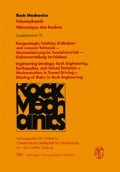Summary
Neotectonics and Its Implications on Engineering Geology. The report starts by setting out the meaning and the purposes of a comparably recent branch of study belonging to the Earth Sciences, i.e. Neotectonics. Neotectonics focuses on the most recent activity of tectonic structures in line with the most advanced geodynamic theories. Some patent examples of uplifting areal structures and of active linear structures (faults), which are deformations under way, are illustrated.
A number of countries have realized the importance of these studies and have therefore drawn up neotectonic maps, or are currently doing so. Today, these maps are mainly meant to detect “seismogenetic zones” so as to assess the “seismic risk”. The results of these studies highlight a social and economic interest in both land-use planning and in the designing of big engineering projects (viaducts, tunnels, hydroelectric and nuclear power plants, .....).
The implications of neotectonics, as well as the way some phenomena (such as slides, subsiding of the ground, major fracture belts, ...) can be explained, are therefore considered in the light of a new interpretation.
Zusammenfassung
Neotektonik und ihre Bedeutung für die Ingenieurgeologie. Der 13ericht beginnt mit einer Schilderung der Bedeutung und der Ziele einer unter den Erdwissenschaften verhältnismäßig neuen Disziplin, der Neotektonik. Im Einklang mit den modernsten geodynamischen Theorien untersucht sie die Tätigkeit der tektonischen Strukturen in neueren geologischen Zeiten.
Es werden einige besonders auffallende Beispiele von sich erhebenden Arealstrukturen und sich bewegenden Linearstrukturen (Verwerfungen), d.h. von gegenwärtig vorkommenden Verformungen, geschildert.
Die Bedeutung dieser Forschungen wurde schon in mehreren Ländern erkannt, wo neotektonische Karten schon ausgearbeitet wurden oder sich derzeit in Ausarbeitung befinden. Diese zielen nun vor allem auf die Ermittlung der „seismogenetischen Räume“, d.h. auf die Einschätzung des Erdbebenrisikos.
Die Ergebnisse dieser Forschungen haben daher eine sozialwirtschaftliche Bedeutung sowohl für die Flächenwidmungspläne als auch für die Planung großer Bauwerke (Talbrücken, Tunnel, Wasser-und Kernkraftwerke usw.).
Daher wird die Bedeutung solcher neotektonischer Erscheinungen im Hinblick auf die technische Geologie analysiert und es wird gezeigt, wie gewisse Probleme (Erdrutsch, Unterbodensenkungen, Bruchstreifen usw.) anhand dieser neuen Auslegung eine Erklärung finden können.
Access this chapter
Tax calculation will be finalised at checkout
Purchases are for personal use only
Preview
Unable to display preview. Download preview PDF.
References
Carraro, F., Polino, R.: Vistose deformazioni in depositi fluviolacustri quaternari a Ponte Racli (Valle del T. Meduna — Prov. di Pordenone). Gruppo di studio del Quaternario Padano; Quaderno n° 3, 78–88, Torino (1976).
Panizza, M., Carton, A., Castaldini, D., Mantovani, F., Spina, S.: Esempi di morfoneotettonica nelle Dolomiti occidentali e nell’ Appennino modenese. Geogr. Fis. Dinam. Quat. 1 (1), 28–54, Torino (1978).
Gerasimov, I. P.: Experience with Geomorphological Interpretation of the General Scheme of Geological Structure of URSS. Probl. Fizich. Geogr. 12, 89–115 (1946).
Panizza, M., Piacente, S.: Convergenza geomorfologica di morfosculture eterogenetiche. Messa a punto per ricerche di Neotettonica. Gruppo di studio del Quaternario Padano. Quaderno n° 3, 39–44, Torino (1976).
Talamo, R., Pampaloni, M., Grassi, S.: Risultati delle misure di livellazione di alta precisione eseguite dall’ Istituto Geografico Militare nelle zone del Friuli interessate dalle recenti attivita sismiche. Boll. Geod. Sc. Aff., 37, 61–75 (1978).
Carraro, F.: Appunti sulla tettonica quaternaria. Gruppo di studio del Quaternario Padano. Quaderno n° 3, 1–19, Torino (1976).
Ambrosetti, P., Bonadonna, F. P., Bosi, C., Carraro, F., Cita, B. M., Ciglia, G., Manetti, P., Martinis, B., Merlo, C., Panizza, M., Papani, G., Rampoldi, R.: Proposta di un progetto operativo per l’ elaborazione della Carta Neotettonica d’ Italia. C. N. R., Progetto Finalizzato Geodinamica, Sub-progetto Neotettonica, Roma (1976).
Bosi, C.: Relazione introduttiva al tema “Neotettonica”. 69° Congr. Soc. Geol. It. Perugia (1978).
Panizza, M., Piacente, S.: Rapporti fra geomorfologia e neotettonica. Messa a punto concettuale. Geogr. Fis. Dinam. Quat. 1 (2), 138–140, Torino (1978).
Amato, A., Barnaba, P. F., Finetti, L, Groppi, G., Martinis, B., Muzzin, A.: Geodynamic Outline and Seismicity of Friuli-Venezia Giulia Region. Boll. geof. teor. appl. 72 (2), Trieste (1976).
Bosi, C., Camponeschi, B., Giglio, G.: Indizi di possibili movimenti lungo faglie in occasione del terremoto del Friuli del 6 maggio 1976. Boll. Soc. Geol. It. 95, Roma (1976).
Atomic Energy Commission. Seismic and Geological Sitting Criteria for Nuclear Power Plants. U. S. Federal Register, 38, 31279–31285 (1973).
Sherard, T. L., Cluff, L. S., Allen, C. R.: Potentially Active Faults in Dam Foundation. Geotechnique, 24, 367–428 (1974).
Author information
Authors and Affiliations
Editor information
Editors and Affiliations
Rights and permissions
Copyright information
© 1980 Springer-Verlag Wien
About this paper
Cite this paper
Carulli, G.B. (1980). Neotectonics and Its Implications on Engineering Geology. In: Müller, L. (eds) Baugeologie, Felsbau, Erdbeben und rezente Tektonik — Mechanisierung im Tunnelvortrieb — Riskenverteilung im Felsbau / Engineering Geology, Rock Engineering, Earthquakes, and Actual Tectonics — Mechanization in Tunnel Driving — Sharing of Risks in Rock Engineering. Rock Mechanics, vol 10. Springer, Vienna. https://doi.org/10.1007/978-3-7091-4161-8_4
Download citation
DOI: https://doi.org/10.1007/978-3-7091-4161-8_4
Publisher Name: Springer, Vienna
Print ISBN: 978-3-211-81601-1
Online ISBN: 978-3-7091-4161-8
eBook Packages: Springer Book Archive

